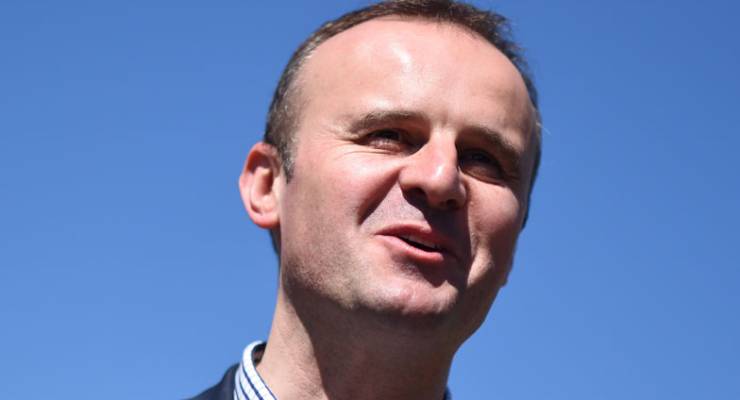
ACT Chief Minister Andrew Barr
Tempting though it may be to dismiss the notion that Canberra’s rarefied air could ever provide a barometer reading of the national mood, the surprising result of Saturday’s ACT election is not without broader implications, including for denizens of the larger of the city’s two parliamentary complexes.
Labor’s victory was the fifth in a winning streak going back to 2001, and sets it up for 19 years in office by the time the next election rolls around in another four years’ time.
While a Liberal defeat in the national capital can only ever come as so much of a shock, few in the party would have been quite so pessimistic as to have anticipated a 3% drop in their vote off a losing performance in 2012.
Indeed, the Liberals had seemed genuinely hopeful that the election would play out as another salutary lesson for Labor in the dangers of getting too close to the Greens.
Labor has spent the last term in government by the grace of Greens member Shane Rattenbury, who has sat between Labor and Liberal contingents of eight members each, as the sole occupant of the crossbench.
The accommodation Labor reached with Rattenbury after the 2012 election involved both policy concessions and a position on what was, initially, a cabinet of just five members.
For the Liberals, this suggested encouraging parallels with Julia Gillard’s position after the 2010 federal election and the then Labor-Greens government in Tasmania, and the landslide Liberal victories that respectively followed in 2013 and 2014.
The centrepiece of Labor’s deal with Rattenbury was an agreement to move forward with a 12 kilometre light rail project between the city and the northern suburban centre of Gungahlin, at a projected cost approaching $1 billion.
[Poll Bludger: the electorates to watch in tomorrow’s ACT election]
As the Liberals saw it, their challenge and opportunity was to ensure that the project did for Katy Gallagher and her successor, Andrew Barr, what the carbon tax did for Julia Gillard.
That this involved taking an axe to a popular public infrastructure project, rather than what Tony Abbott portrayed as a “tax on everything”, was not seen as an insoluble difficulty.
The electoral benefit to Labor was constrained by the fact that the project was only to service the northern part of the city, leaving voters in the south to carry the can for something that was, at best, of indirect benefit to them.
Labor’s sensitivity to this charge was demonstrated by a campaign promise to spend $25 million on planning for the second stage of the project, which will extend the line south of Lake Burley Griffin to Woden.
The Liberals were also able to point to a Productivity Commission finding that concurred with their view that the project’s benefits could be conferred at lower cost by rapid bus transit, which added extra force to their attacks on the government over land rates hikes.
To further adjust their pitch to voters’ social democratic sensibilities, the Liberals’ campaign material emphasised that the savings could free up money for spending on health and education.
However, it may be that Canberra voters had enough political awareness to be reminded of the strikingly similar claims that were made during the Brexit campaign, and concluded that the Liberal policy would amount to nothing more than an austerity measure.
The Liberals were not helped on this count by the doctrinaire tendency that the local party has acquired of late.
Twice-defeated former leader Zed Seselja now serves in the Senate as a standard bearer for the conservative cause, and he has a number of spiritual successors in the territory Parliament — notably the fast-rising 32-year-old deputy leader, Alistair Coe.
The party’s current leader, Jeremy Hanson, sold himself during the campaign as a moderate, but to the extent that this was so, his military background and bearing may have prevented it from coming across.
The light rail issue at least played out as planned to the extent that the Liberals did relatively well in the city’s inner south, particularly in the district of Murrumbidgee, where they are in contention to win three of the five seats.
In the central Canberra district of Kurrajong, which is a persistent weak spot for the Liberals, there was a noticeable distinction between the booths north of the lake, which swung to Labor, and those to the south, which went the other way.
However, the other side of this pattern is that the Liberals bombed in the northern Canberra districts of Yerrabi and Ginninderra, which was where the election stood to be won and lost.
Furthermore, the light rail issue tells only half the story of the geographic spread of the result — and it’s the other half that should give Malcolm Turnbull and others cause to take notice.
This was the particularly strong performance by Labor in the newer, mortgage-paying suburbs at the city’s top and tail.
In the district of Brindabella, which covers the developing Tuggeranong region in Canberra’s outer south, the mortgage belt swing to Labor more than cancelled out the Liberals’ southern suburban light rail dividend, although the Liberals were still able to defend their existing three seats.
At the other end of town, in the Gunghalin region district of Yerrabi, light rail and the mortgage belt effect combined to deliver Labor its best result of all, with their own vote up by 6% while the Liberals fell 5%.
These results can be read as a complement to the Turnbull government’s near defeat at the federal election in July on the back of devastating swings on the city fringes.
Voters in such areas had earlier formed a crucial part of the coalition that sustained John Howard through a decade in office, in large part because they credited his government with low interest rates, and were also highly responsive to Tony Abbott’s scorched-earth campaign against the carbon tax.
Saturday’s result emphasises the fact that the Liberals are presently lacking a bread-and-butter economic narrative to pitch to these voters, who are instead prioritising issues of service delivery that play to the advantage of Labor.
This is particularly bad news for the conservative government in Western Australia, which faces an election in less than five months against a Labor opposition that spent nearly five years promoting a promised expansion of the Perth rail network.
It also suggests that the trends evident in July are continuing to play out to the detriment of a federal government that shows few signs of formulating a coherent strategy to address them.








I think this is a fundamental misreading of the result. Another view is that Canberra is a public service town and public servants – Federal or local – see Labor as their natural friend. Everyone I know who voted Labor did so in spite of the tram, not because of it. They voted Labor for its social policies, Liberal promises here losing huge credibility from the Feds, not for its desire to dig a huge tram-shaped hole and fill it with ratepayers’ money. Again and again.
Labor+Greens have gone from 9/17 seats (53%) to (it appears) 13/25 seats (52%) so, as far as ringing endorsements of the Barr-Rattenbury Memorial Tram go, I just don’t see it.
It was pleasing to see voters somewhere (anywhere) rejecting a campaign of fear and voting for a positive plan aimed at extending infrastructure. Gives one hope that parties can campaign on solid issues and win. As the light rail project was at the centre of the campaign, there seems no doubt that voters were endorsing it.
Where is the surprise? Labor were $1.17 to win and the Libs were $2.00. 17% tax free return over the weekend. Easy money. Always back the horse called Self Interest. Cheers, Michael
@Decorum
Just to correct your numbers in the final paragraph: Labor will get at least 12, Greens will get 2, makes 14 (56%), so the Labor + Green government’s majority has increased. On that basis it can surely be read as an endorsement of and reward for the arrangement.
Still not an overwhelming surge of support, in my view, but I stand corrected on the numbers – thanks for the update.